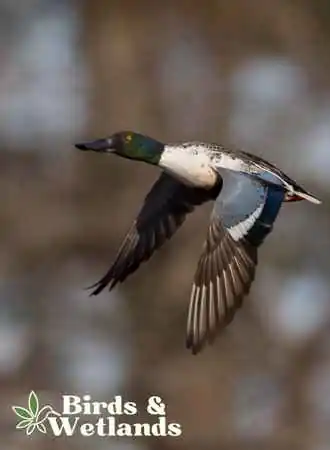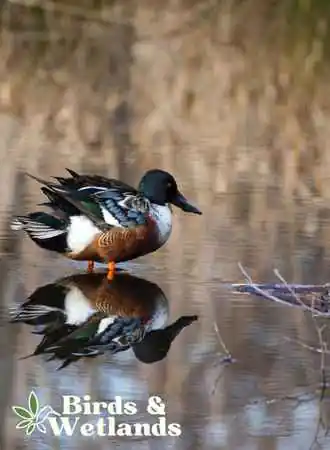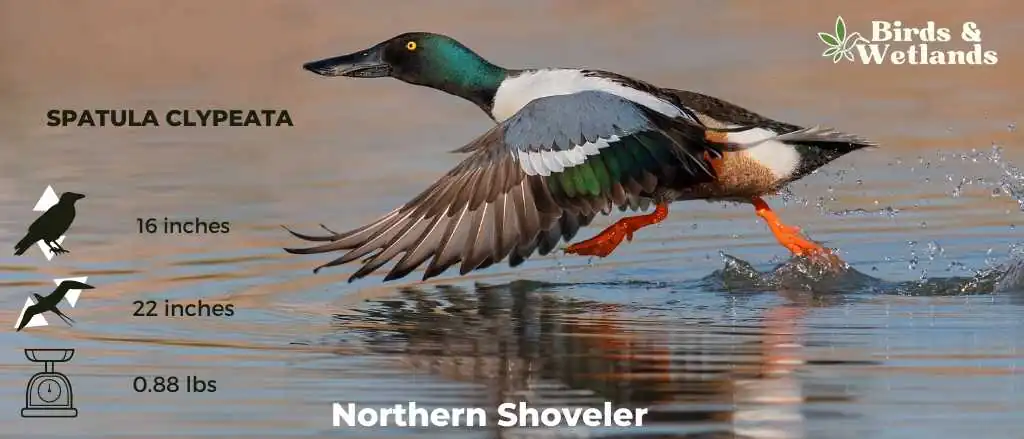The northern shoveler is a medium-sized dabbling duck with a wide geographical range in the northern hemisphere. It is widespread in the northern parts of Europe, the Palearctic and North America.
Swedish naturalist Carl Linnaeus formally described the species and introduced its former binomial, Anas clypeata, in 1758.
Order: Anseriformes
Family: Anatidae
Scientific Name: Spatula clypeata
Height: 16 in (41 cm)
Wingspan: 22-inch (560 mm)
Weight: 14 oz (400 g)
Northern Shoveler Description
Breeding male shovelers have an iridescent dark green head, a white breast and reddish-brown flanks.
Females, juveniles, and non-breeding males have mottled brown heads, bodies, and powder-blue shoulder patches.

Listen to Northern Shoveler
During courtship, the male gives a wheezy “took-took” sound while the female makes a nasal-sounding quack.
Northern Shoveler Habitat
Northern Shovelers breed in areas with shallow water with plenty of aquatic vegetation and invertebrate life. This could be anything from freshwater marshes and ponds to tundra and prairies. In all cases, the birds prefer sites near the water and with thick vegetation.
In North America, northern shovelers migrate south for the winter. They spend winters in the southern parts of the United States, with some flocks even venturing further south into northern Mexico. These ducks are also common visitors to the Caribbean and Central America.
These ducks use a wide range of winter habitats, including shallow lakes, marshes, coastal lagoons and estuaries. Some flocks even spend winters in areas neglected by other ducks, such as stagnant and polluted waters.

Northern Shoveler Range
Northern shovelers live throughout much of the northern hemisphere. In North America, these ducks breeds in Alaska, northern regions of Manitoba in Canada and the Prairie pothole region of the United States. Some flocks are also breeding in northern California and the Great Lakes region.
These ducks are early fall and late spring migratory birds.

Northern Shoveler Diet
Northern shovelers are omnivores that feed primarily on aquatic plants, including seeds, sedges and tubers. These ducks feed by dabbling and use their bills with comb-like structures to strain food from the water. They supplement their diet with other food sources, such as insects, mollusks, crustaceans and other aquatic invertebrates.

Northern Shoveler Nesting & Mating Habits
Northern shovelers breed in single pairs or loose groups from early April to late June.
Female northern shovelers choose the nesting site, usually in bushes and tall grass and close to the water. They make a shallow depression on the ground and build a nest out of grass and weeds. The nest is usually lined with down feathers.
The female lays between 9 to 12 pale olive eggs, which she incubates alone for 21 to 27 days. During incubation, the male stands nearby to guard the nest and his mate.
Upon hatching, the female leads the northern shoveler ducklings away from the nest and into the water. Young ducks fledge between 35 to 66 days from hatching, depending on their location.
Northern Shoveler Population & Conservation Status
The northern shoveler has an estimated global breeding population of around 6 million. Due to their rising numbers, the current conservation status of this species is “Least Concern”.

Northern Shoveler Hunting
Hunting northern shovelers are legal in most states during the waterfowl hunting season. In coordination with state governments, the U.S. Fish and Wildlife Service set daily bag and possession limits to manage the population of this duck species.
Key Points
- Northern shovelers have a large spoon-shaped bill.
- Like most other dabbling ducks such as the blue-winged teal, northern shovelers feed by dabbling in the water.
- The male has a white chest and breast and chestnut belly and flanks.
- The female has an oversized orange bill, while the male has an oversized black bill.
- These ducks build their nest in grassy areas near the water during the breeding season.
- Male calls resemble wheezy sounds while females make mallard-like quacks.


